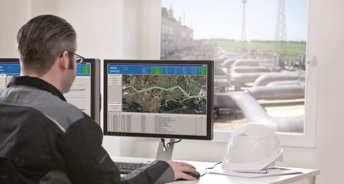
7 minute read
Pipelines E-RTTM model is central to pipeline safety designs
RELIABLE LEAK MONITORING FOR PIPELINES
Jay Gadhavi, KROHNE Middle East and Africa solutions director, discusses the benefits of Extended Real Time Transient Modelling (E-RTTM) leak detection systems as a central component of pipeline safety design.
THE TRANSPORTATION OF FLUIDS in pipelines is increasing all over the world, and with good reason: pipelines are among the safest and most economical transportation systems over long routes. Special leak detection systems are often used to limit the risks. In general, leak detection in pipelines refers to the recognition and quick localisation of product leaks.
Reasons to employ leak detection include: 6 To minimise the effects of accidents 6 To minimise downtime 6 To minimise product loss 6 Regulatory compliance.
Leak detection in pipelines can be performed in various ways, from simple visual controls during inspections, to computersupported systems that monitor conditions, even for underground and undersea pipelines. Getting started
Selecting a suitable leak detection system is not an easy task for pipeline operators. API RP (Recommended Practice) 1130 is even more specific with regard to leak detection systems. Among other items, it includes a collection of general recommendations for operating leak detection systems, such as clear presentation of the results for the operator and for maintenance. It also includes performance criteria for selecting a leak detection system: these criteria are very detailed and explain how leak detection systems work. The criteria are outlined below, and it is easy to see that they are linked and interdependent. 6 Sensitivity: the leak detection system should detect even small leaks within a short period. 6 Precision: the leak detection system should locate leaks precisely. The leakage rate, the quantity of escaped product (leakage rate multiplied by time) and the product that is
escaping should all be indicated. 6 Robustness: the leak detection system should continue active monitoring despite unsteady or non-ideal conditions. It also includes unsteady operating conditions, also known as transient operation, for example due to effects triggered by pumps or valves. 6 Reliability: the leak detection system should not generate false alarms, even though it is highly sensitive.
Leak detection minimises the effects of accidents, reduces downtime and product loss and aids compliance.
Canadian standards
Association CSA Z662 Annex E represents recommended practice for liquid hydrocarbon pipeline system leak detection in Canada. Hereby, the CSA Z662 Annex E is the only recommended practice to include precise uncertainties for leak detection systems. When the operator has clarified relevant requirements of the appropriate regulatory for their application, other characteristics that affect the choice of leak detection system can be considered.
Combining principles has several advantages. In 2012, the U.S. Department of Transportation Pipelines and Hazardous Materials Safety Administration published a Leak Detection Study, DTPH56-11-D000001, which states, “The leak detection system itself should always be redundant, by using multiple techniques that differ from each other and therefore compensate for any inherent weaknesses they do not share.” It also describes the benefits of combined leak detection methods, “There is no reason why several different internal
leak detection methods should not be implemented at the same time. As an example, the Extended-RTTM system trademarked by KROHNE uses an RTTM in conjunction with several other API 1130 techniques”. (E-RTTM stands for Extended RTTM, which combines the RTTM principle with leak signature analysis using leak pattern detection).
Benefits of E-RTTM systems
An E-RTTM leak detection system creates a virtual image of a pipeline based on real measured data. If the model detects a flow discrepancy, the leak signature analysis module then determines whether it was caused by an instrument error, a gradual leak or a sudden leak.
The increased capacities of modern computers allow leak signature analysis to apply powerful statistical hypothesis testing. Based on modern statistical tests, the signature analysis decides whether the pipeline is affected by a leak or not. It provides a high degree of sensitivity and quick leak detection with real-time comparison of existing measuring results against leak signatures, which are stored in a database.
E-RTTM-based leak detection systems are able to handle changing or transient operating conditions that are not recognised by less sophisticated internal leak detection systems. An E-RTTMbased leak detection system works with dynamic values, which also affects robustness: the system can adapt automatically and very quickly to changes in the operating conditions such as sensor failure, communications failure, a valve closing or a product change in the pipeline.
The precision of the E-RTTM is based on three different methods of leak localisation: gradient intersection method, wave propagation method and extended wave propagation method. The leak detection system calculates the most probable leak location(s) by comparing the results of these methods. The gradient intersection method is based on the pressure profile of a pipeline: the occurrence of a leak changes the pressure gradient along the pipeline in characteristic manner. Without a leak, the drop in pressure in a liquid pipeline is linear. The leak position can be determined by calculating the intersection point.
The second option for leak localisation is the wave propagation method, which analyes the pressure waves that result from a leak. If a sufficiently large enough leak occurs suddenly, for example if the pipeline is damaged by an excavator, a negative pressure wave spreads at the speed of sound in both directions along the pipeline. The leak position can be calculated by comparing the arrival time of the pressure wave at the pipeline inlet and outlet pressure sensors.
The extended wave propagation method is based on the same physical principle as the wave propagation method. This enables more precise localisation of the leak by reducing errors due to delayed sensor reaction or slow signal transfer.
The E-RTTM introduced here is the basis of the PipePatrol leak detection system by KROHNE. The user interface can run on a separate workstation, or be integrated into an existing control system. The user interface features intuitive operation: only the information that the current user needs for his scope of work is displayed.
In principle, PipePatrol can be integrated into any new or existing infrastructure. Operators can learn to use the system in just a few hours. In addition to the visualisation of the pipeline operating conditions, PipePatrol can indicate leak positions on a map, which simplifies and speeds up a service technician's work.

An E-RTTM leak detection system creates a virtual image of a pipeline based on real measured data.
Image Credit: KROHNE
Leak detection in practice
An example application in Canada demonstrates how quickly and precisely leak detection functions in practice. Following thorough consultation, the company opted for the PipePatrol leak detection system. PipePatrol used the measurement values provided by the process control system and was integrated into the pipeline monitoring system at the customer’s request. The leak tests performed for the site acceptance tests were conducted using valves in the pipeline to simulate leaks by real fluid withdrawal into a vacuum truck. The detection threshold for leaks is set to 1.1 m3/h / 4.84 gal (US)/min. After starting the leak test with a leak rate of 5 m3/h / 22.01 gal (US)/min, the system recognised the signature of the leak within 55 seconds and went to “Leak Signature Detected” state.
The gradient intersection method calculated a leak position of 24,689 m / 15.34 mi, while the wave propagation method calculated a leak position of 24,677 m / 15.33 mi, both less than 0.1% of pipeline length away from the real leak position.
The second pipeline is a sales oil pipeline with a length of 59,700 m / 37.1 mi. The detection threshold for leaks is set to 3 m3/h / 13.21 gal (US)/min. After starting the leak test with a leak rate of 3.5 m3/h / 15.41 gal (US)/min, the system recognised the signature of the leak within 50 seconds and went to “Leak Signature Detected” state. The gradient intersection method calculated a leak position of 0 m / 0 mi, less than 0.1% of pipeline length away from the actual leak position. The wave propagation method was disabled for this test because time stamping was temporarily not available for the measurements, but has been activated in the meantime.
Modern leak detection systems are based on various mathematical and physical models. E-RTTM-based leak detection systems guarantee reliable leak monitoring for various types and lengths of pipelines, even under transient operating conditions. KROHNE supplies the PipePatrol ERTTM-based leak detection system either installed on separate hardware or for integration into an existing control system and measurement installation, always to international standards trusted by the industry.









